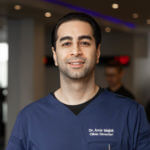
What is Athletic Therapy?
Patients often ask us, what is Athletic Therapy and how is it different from Physiotherapy?
Athletic Therapy – as defined by the Ontario Athletic Therapists Association, is a health care profession that specializes in the prevention, assessment and care of musculoskeletal disorders (muscles, bones, joints) especially as they relate to athletics and the pursuit of physical activity.
Certified Athletic Therapists primarily work in two settings, on the field and in clinic.
On the field of play, athletic therapists are the first to respond when an injury occurs. They are experts at evaluating the nature and severity of an injury, including management of acute symptoms and recognition of traumatic neurological dysfunction (such as concussions). Athletic therapists are certified First Responders who are qualified to provide basic emergency life support if needed. They are skilled in making decisions about if and when it is safe to return to play and often apply prophylactic taping and bracing measures for injury prevention.
Clinically, athletic therapists utilize the Sports Medicine Model of care. They promote optimal healing after injury and assist in restoring, maintaining and exceeding the necessary level of physical performance needed for a safe and rapid return to sport; while avoiding injury in the future. Therapy usually includes a combination of patient education, therapeutic modalities (ultrasound, shockwave therapy, etc.), exercise prescription, manual therapy and physical reconditioning.
Generally speaking, athletic therapy and physiotherapy are very similar professions in terms of clinical treatment styles and techniques. Other than a difference in educational background; the main distinction between the two is their scope of practice.
Athletic therapists specialize in orthopaedics (muscles, bones, joints) and the rehabilitation of sport-specific injuries. Where as, physiotherapists employ a much wider scope of practice, including neurological disorders, cardio-respiratory rehab, pelvic floor, stroke rehab, paediatrics and geriatrics; along with orthopaedics. Physiotherapists are also permitted to use acupuncture in their treatments after completion of required training.
At Push Pounds Sports Medicine, our rehabilitation department embodies a multidisciplinary approach to health and wellness. Our team of Athletic Therapists, Physiotherapists, Massage Therapists, Chiropractors and Orthopaedic Surgeons work together to provide our clients with a gold standard level of care.
Who would benefit from seeing an Athletic Therapist?
While the primary target patient for athletic therapists are individuals that lead an active lifestyle and are regularly dependent on their optimal physical fitness; anyone can benefit from seeing an athletic therapist. We treat a wide range of patients, from kids with concussions to seniors recovering from hip replacement surgery and everything in between. We treat almost all muscle strains, ligament sprains and joint dysfunctions in the body using the various techniques listed above. The treatment will vary but the objective does not. Our goal is to help our clients return to their usual activities, whether that means playing competitive sports or playing with their grandkids.
Conditions we commonly see and treat include, but are no limited to:
- Ankle sprains
- Plantar fasciitis
- MCL sprains
- Meniscus tears
- Post-op ACL reconstruction
- Groin strains
- SI joint dysfunction
- Sciatica/piriformis syndrome
- Knee/hip arthritis
- Repetitive strain injuries (tennis elbow)
- Herniated discs
- Rotator cuff strains/tears
The ideal time to start treatment of any injury is during the acute stages (right away), however there is never a bad time to come in for treatment. Perhaps you are in a later stage of rehab and can’t seem to regain that last 10-15% of your mobility or strength. This is where we can help you!
If you have extended healthcare benefits through your employer there is a good chance you are covered for athletic therapy treatments. In Ontario, most major insurance companies such as Manulife, Sun Life, Great West Life, Blue Cross, Greenshield, Desjardin, Standard Life, and Empire Life, all cover athletic therapy. We recommend you call your insurance company to confirm before seeking treatment or give us a call and we can help you find out.

